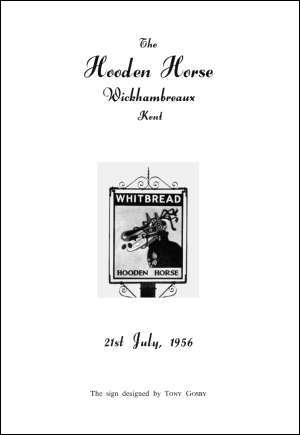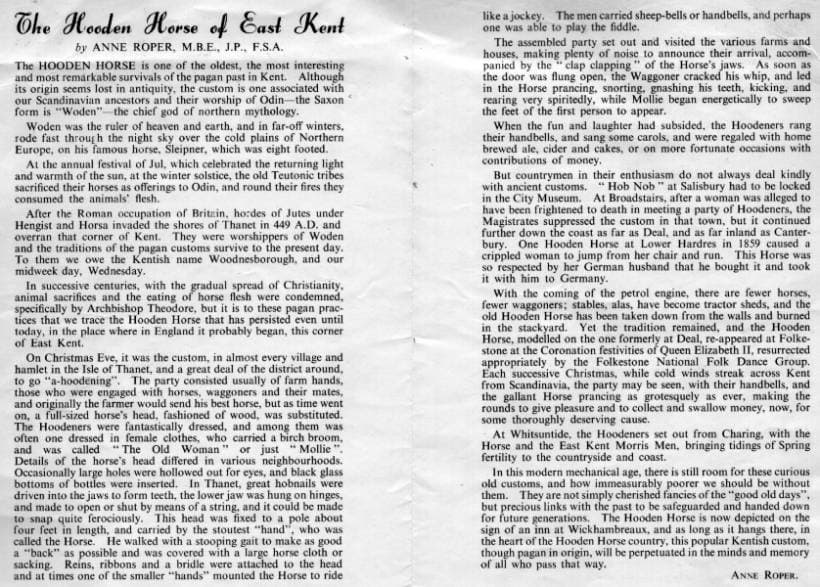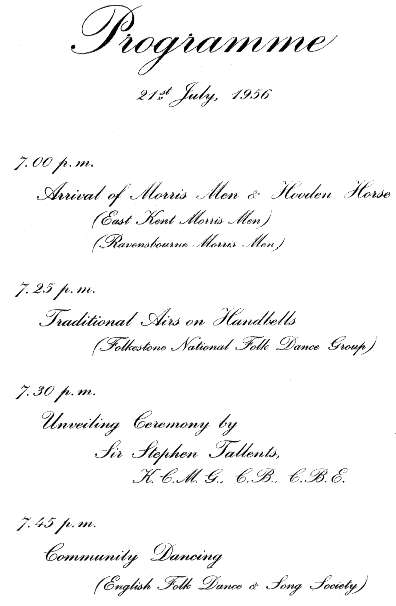The "Hooden Horse", Wickhambreaux
Here is a scanned copy of the leaflet issued when the "Hooden Horse" pub in Wickhambreaux was renamed as such on 21 July 1956.




Programme 21st July, 1956 7.00 p.m. Arrival of Morris Men & Hooden Horse. (East Kent Morris Men) (Ravensbourne Morris Men) 7.25 p.m. Traditional Airs on Handbells. (Folkestone National Folk Dance Group.) 7.30 p.m. Unveiling Ceremony by Sir Stephen Tallents, KCMG, CB, CBE 7.45 p.m. Community Dancing (English Folk Dance & Song Society.) The Hooden Horse of East Kent by Anne Roper, MBE, JP, FSA The "HOODEN HORSE" is one of the oldest, the most interesting and most remarkable survivals of the pagan past in Kent. Although its origin seems lost in antiquity, the custom is one associated with our Scandinavian ancestors and their worship of Odin — the Saxon form is "Woden" — the chief god of northern mythology. Woden was the ruler of heaven and earth, and in far-off winters, rode fast through the night sky over the cold plains of Northern Europe, on his famous horse, Sleipner, which was eight footed. At the annual festival of Jul, which celebrated the returning light and warmth of the sun, at the winter solstice, the old Teutonic tribes sacrificed their horses as offerings to Odin, and round their fires they consumed the animals' flesh. After the Roman occupation of Britain, hordes of Jutes under Hengist and Horsa invaded the shores of Thanet in 449 A.D. and overran that corner of Kent. They were worshippers of Woden and the traditions of the pagan customs survive to the present day. To them we owe the Kentish name Woodnesborough, and our midweek day, Wednesday. In successive centuries, with the gradual spread of Christianity, animal sacrifices and the eating of horse flesh were condemned, specifically by Archbishop Theodore, but it is to these pagan practices that we trace the Hooden Horse that has persisted even until today, in the place where in England it probably began, this corner of East Kent. On Christmas Eve, it was the custom, in almost every village and hamlet in the Isle of Thanet, and a great deal of the district around, to go "a-hoodening". The party consisted usually of farm hands, those who were engaged with horses, waggoners and their mates, and originally the farmer would send his best horse, but as time went on, a full-sized horse’s head, fashioned of wood, was substituted. The Hoodeners were fantastically dressed, and among them was often one dressed in female clothes, who carried a birch broom, and was called "The Old Woman" or just "Mollie". Details of the horse’s head differed in various neighbourhoods. Occasionally large holes were hollowed out for eyes, and black glass bottoms of bottles were inserted. In Thanet, great hobnails were driven into the jaws to form teeth, the lower jaw was hung on hinges, and made to open or shut by means of a string, and it could be made to snap quite ferociously. This head was fixed to a pole about four feet in length, and carried by the stoutest "hand", who was called the Horse. He walked with a stooping gait to make as good a "back” as possible and was covered with a large horse cloth or sacking. Reins, ribbons and a bridle were attached to the head and at times one of the smaller "hands" mounted the Horse to ride like a jockey. The men carried sheep-bells or handbells, and perhaps one was able to play the fiddle. The assembled party set out and visited the various farms and houses, making plenty of noise to announce their arrival, accompanied by the "clap clapping" of the Horse's jaws. As soon as the door was flung open, the Waggoner cracked his whip, and led in the Horse prancing, snorting, gnashing his teeth, kicking, and rearing very spiritedly, while Mollie began energetically to sweep the feet of the first person to appear. When the fun and laughter had subsided, the Hoodeners rang their handbells, and sang some carols, and were regaled with some brewed ale, cider and cakes, or on more fortunate occasions with contributions of money. But countrymen in their enthusiasm do not always deal kindly with ancient customs. "Hob Nob" at Salisbury had to be locked in the City Museum. At Broadstairs after a woman was alleged to have been frightened to death in meeting a party of Hoodeners, the Magistrates suppressed the custom in that town, but it continued further down the coast as far as Deal, and as far inland as Canterbury. One Hooden Horse at Lower Hardres in 1859 caused a crippled woman to jump from her chair and run. This Horse was so respected by her German husband that he bought it and took it with him to Germany. With the coming of the petrol engine, there are fewer horses, fewer waggoners; stables, alas, have become tractor sheds, and the old Hooden Horse has been taken down from the walls and burned in the stackyard. Yet the tradition remained, and the Hooden Horse, modelled on the one formerly at Deal, re-appeared at Folkestone at the Coronation festivities of Queen Elizabeth II, resurrected appropriately by the Folkestone National Folk Dance Group. Each successive Christmas, while cold winds streak across Kent from Scandinavia, the party may be seen, with their handbells, and the gallant Horse prancing as grotesquely as ever, making the rounds to give pleasure and to collect and swallow money, now, for some thoroughly deserving cause. At Whitsuntide, the Hoodeners set out from Charing, with the Horse and the East Kent Morris Men, bringing tidings of Spring fertility to the countryside and coast. In this modern mechanical age, there is still room for these curious old customs, and how immeasurably poorer we should be without them. They are not simply cherished fancies of the "good old days", but precious links with the past to be safeguarded and handed down for future generations. The Hooden Horse is now depicted on the sign of an inn at Wickhambreaux, and as long as it hangs there, in the heart of the Hooden Horse country, this popular Kentish custom, though pagan in origin, will be perpetuated in the minds and memory of all who pass that way. Anne Roper
This page forms part of The Hoodeners site, hoodening.org.uk
Back to Hoodening history 1945-64